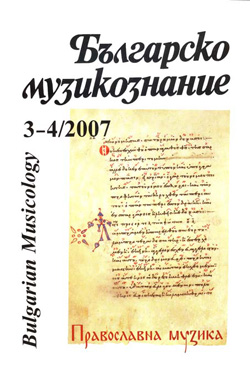Църковнопевчески школи - средища на българското църковно пеене през Възраждането
Church Singing Schools - Centers of Bulgarian Church Singing During the Revival Period
Author(s): Stefan HarkovSubject(s): Music
Published by: Институт за изследване на изкуствата, Българска академия на науките
Summary/Abstract: This paper traces the understanding of the concept “singing schools” during the Bulgarian Revival Period, taking into account the definition offered by the prominent Bulgarian authority on liturgical singing Petur Dinev (1889-1980). According to his definition, a liturgical singing school refers to a clearly local but Churchill song practice that can be distinguished by its particular manner of interpretation. The author traces the development of the Balkan liturgical singing tradition from the second half of the 17th century, when the process of so-called “musical exegesis”, which was, in the author’s opinion, a process of decoding the previously encoded system of knowledge within the realm of a turtle music. The goal of this decoding was to preserve the tradition. The major schools are identified, i.e. the centers of Bulgarian Orthodox music: Rila Monastery, which played a fundamental role in the founding of contemporary Bulgarian monophonic but Churchill singing in the Church Slavic language; Bachkovo Monastery; and the Zograf and Hilendar monasteries on Mount Athas. The author also adds to the list of monasterial schools for Bulgarian singing the Ukrainian Great Skit monastery (in the village of Manyavsky, Lvov Region) in eastern Carpathians, which was the center of a song style called “Bolgarskij rospev”.Urban liturgical singing schools are also examined, including those in Veliko Tumovo, Sliven, Koprivshtitsa, Ohrid, Struga, Thessaloniki, and Odrin. He also lists the names of the most prominent figures in the singing schools and briefly outlines their activities. The author concludes that despite the tendency toward stylistic unification in liturgical singing after the appearance of printed songbooks, even in the 20th century individual performances of specific regional musical expressions still have a place. This conclusion reinforces the basic principle that the strength of national unity is founded on the richness of regional variety.
Journal: Българско музикознание
- Issue Year: 2007
- Issue No: 3-4
- Page Range: 210-219
- Page Count: 10
- Language: Bulgarian
- Content File-PDF

